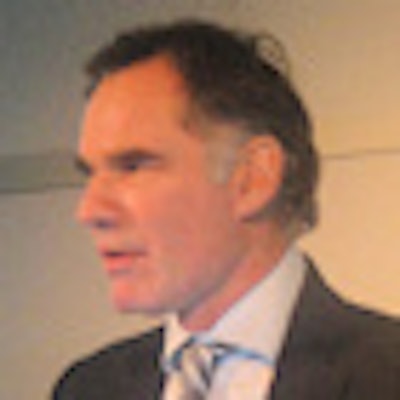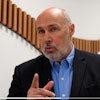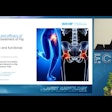
VIENNA - Visibility is the shield that can protect radiology against the slings and arrows steadily lining up against it, according to experts who spoke at a professional challenges session on Friday at ECR 2013.
Visibility is the essence of a more patient-centric, decision-centric role that radiologists have been trying to carve out for themselves in hopes of avoiding commoditization and increasing irrelevance as a profession, they said. For as technology advances and puts increasingly readable images into the hands of nonradiologists, visibility and a far stronger clinical role may well be the only antidotes to reduced reimbursement.
"A lot of things are changing in this world, and if we want to survive as a specialty, I am deeply convinced that we can only survive if we are visible physicians within the hospital and we are needed," said Dr. Jim Reekers, professor of interventional radiology at the University of Amsterdam, who opened the session. "If we're not needed anymore, we're going to be redundant and we're not going to survive."
 Dr. Jim Reekers, professor of interventional radiology at the University of Amsterdam, led off the session.
Dr. Jim Reekers, professor of interventional radiology at the University of Amsterdam, led off the session.
It's easy to see how radiology got where it is by looking at where it's been, he said. It's been known traditionally as a "rather mysterious" and even slightly frightening specialty relegated to dark basement rooms, characterized by the less-than-outgoing practitioner who has little contact with patients or other physicians.
In the Netherlands, other clinicians didn't really even think of radiologists as doctors -- more like the personnel running the "photo department," Reekers said. What communication did occur was conducted largely in writing via the x-ray order. However, today's bright rooms and snazzy machines can't completely overcome radiology's past. Moving the specialty to a better place will require diligent efforts on the part of the specialty to pull itself into the center of patient care.
Far from getting better in recent decades, since the development of CT in the 1970s and MRI in the 1980s radiologists have become even less visible to patients, he said -- though there are a few exceptions such as interventional radiology and gastroenterology, where patients still must meet and consult with their radiologist. To begin to counter these forces, Reekers advises doctors to be part of the hospital team.
"Dress like a doctor; become more visible to patients," he said. "Twenty-five percent of patients are indifferent as to who gives them their imaging result," according to a recent patient survey. "Directly communicating imaging results to patients will enable radiologists to participate in the decision-making process as equal partners in their healthcare."
Recently, some other specialties have taken the lead in reversing the trend toward invisibility, including nuclear medicine, mammography, pediatric radiology, and ultrasound.
"Make a website for your department that provides for questions and answers on imaging," he said. That type of contact in person can even be a challenge architecturally, as many hospitals have offices for radiologists that are physically distant from other clinicians. But if you're in the position to help design a new department, you can help ensure that radiology is at the center of patient care, and at the center of a multidisciplinary team, he said.
Radiologists should also seek to participate in the writing of guidelines and safety documents. And they should provide radiology services 24 hours a day, seven days a week.
Essentially there are two possible models for radiology, he said. The first is the economic model of cost-effectiveness and efficiency, which holds sway in most healthcare institutions today. This model conspires to provide as many reads as possible, as quickly as possible -- and thus moves radiology toward obscurity and commoditization, he said.
In this model, the main communication with the outside world is through reporting. There is no relationship between the product and the customer. This model fairly begs radiologists to be replaced by image interpreters, and you certainly don't have to be a doctor to be a trained image interpreter, Reekers said.
A far better alternative is the "spider model," which provides for strong communication channels, clinical involvement on the part of radiologists, and the "added value" that comes from having their input into patient care. The spider model takes the basic functions of a radiology department and adds value through somewhat new and higher functions, including communicating with clinicians, advising on imaging, safeguarding quality and patient safety, and communicating with patients.
"You have to have good communication channels ... and patient conferences in your department where you have all the clinicians coming together," Reekers said. "We should all be spiders; we should all be the subspecialized radiologist with clinicians all around us, and there is a connection between the doctors and the radiologists," he said. There will be overlap between specialties, of course, and some fine-tuning of roles, but the basic idea is to build clinical-diagnostic units led in large part by the subspecialized radiologists.
"If you hear about a problem somewhere in the web, try to fix it," he said. "Be a constant source of information; try to feed clinicians with new information about imaging." Radiologists should strive to become a part of clinical groups and do their share of the scientific work as well.
Importantly, radiologists should avoid buying into the notion that every radiologist is a general radiologist, and that every radiologist can read every type of image -- that only feeds into the notion of commoditization.
"If you treat this as a commodity, the radiologist and the department are going to be invisible," Reekers said. "Build clinical communication with patients and become a part of the hospital team. Be a spider in the web, try to know what's going on, and be proactive.
"When radiologists become invisible, they become fungible," he said. "If we are all alike, we become a commodity, and commodities are only traded on price.
Teaching the next generation
Making radiologists truly part of the medical team must start with students in medical school, said Dr. Mario Maas, PhD, a radiologist and board chair of the medical faculty at the University of Amsterdam, in his talk.
But communicating with today's medical students means at least trying to speak their language, said Maas, who is responsible for 350 new students every year. Teaching them properly begins with the selection of very good radiological teachers, adept in communication and experts in their subspecialties. Radiology should be part of the medical curriculum in all clinical and preclinical years.
"And you should consider that the student nowadays is not the student we were," he said. "We were the homo sapiens, and they are the homo zappiens."
Which is to say that today's young people are engaged in their electronics and in a mass flight from conversation, Maas said. Today's teacher is adept in monotasking and reading text printed in books; he is competitive and reality-based and thinks games are for children. In comparison, today's students are digital natives, adept at learning at high speeds and at multitasking. They are more collaborative than competitive, they like learning by looking at images and gaming, and they are fantasy-based, he said.
"Interaction is essential, and you can do it easily in small group learning and in large group teaching," Maas said, adding that radiology has a natural advantage because it is image-focused and owns the hospital's computers. "When I give guided tours through the department, they really are keen on the screens we have," he said. "This is a selling point -- use it."
In teaching, you'll want to explore IT experiences with the students, he said. To keep their attention, make learning interactive. Use response systems with clickers, and use smartphone-based software. Twitter and Shakespeak are also good interactive tools.
Getting involved in clinical care
In his talk, radiologist Dr. Eric de Kerviler from the University of Paris said that today's radiologists must become more clinically involved, learning the ins and outs of clinical care along with image interpretation.
 Dr. Eric de Kerviler from the University of Paris.
Dr. Eric de Kerviler from the University of Paris.
For example, radiologists who join tumor boards can design patient-care strategies with their nonradiologic colleagues, he said. To do this successfully, they must be involved in the science, coming prepared with information from nonradiologic journals, keeping informed as to patients' progress, and being ready to offer breaking clinical research from meetings.
As advisors, radiologists can be very helpful, such as in preventing extra scans from being performed. If a 5-mm nodule is found in a patient who is a nonsmoker, for example, it should be the radiologist who keeps a follow-up scan from being performed at three months rather than 12.
"She should be able to argue and to add elements to the discussion of what the clinician requests," de Kerviler said.
Do or die
It's time for radiologists to come out of the dark and take their place as physicians, said Dr. Andy Adam, professor of interventional radiology at the University of London, in his presentation. After all, he said, radiology has a lot going for it these days.
"We're riding the crest of a wave," Adam said. "We've got probably the best images we've ever had, we have structure and function in our imaging, molecular imaging is upon us, and all the images we produce are now instantly available throughout the hospital. And the workload is increasing, which is a vote of confidence in radiology."
No matter which projection you consider, they all predict that many more radiologists will be needed in the years to come, he said. Used appropriately, radiology increases the effectiveness of treatment, reduces the number of days a patient needs to stay in the hospital, and offers the most efficient use of the healthcare budget.
The opportunity exists for radiology to become the pivotal specialty, determining the pathways to the management of most diseases. It can also become the specialty around which future hospitals will be designed, "because many of the treatments that are available today are based on the results of imaging," Adam said.
 Dr. Andy Adam, professor of interventional radiology at the University of London.
Dr. Andy Adam, professor of interventional radiology at the University of London.
Still, the reality is that radiology is viewed with suspicion, he said. Its capital costs are high, its benefits can be less than obvious, and hospitals are going all out to control costs by emphasizing volume over quality and trying to control "overutilization" -- in essence, encouraging the commoditization of the specialty.
"Radiologists really need to realize that they're living on borrowed time," Adam said. "If you think about it, what we do isn't that different from what an interpreter does. An interpreter tells you what a language you can't understand is telling you. He or she is reading something you can't decipher. "
Radiologists have done much the same thing, he said. Until recently, the images have been fuzzy and hard to understand. But all that is changing with advancing technology that can render 3D images in color that are much easier for nonradiologists to read. At the same time, clinicians are making and using their own images more frequently, such as for surgical planning, and they're getting used to them, Adam said.
The radiology report is considered the end product of what radiologists produce -- radiologists, in fact, encourage others to think of it that way. But without enhancement of the role, the product of the radiologist can only become commoditized and far cheaper.
To establish a new role for themselves, radiologists must get used to being the patient's doctor, he said. They must hone their communications skills through training, secure consulting rooms to meet with patients, and establish strong communications links with referrers.
"Imaging is central to modern patient care," Adam said. "We've already got a role in every step of the pathway. We've got the means of accurate diagnosis, we've got therapy, and very soon we'll have noninvasive therapy such as ultrasound treatment."
"This is the era of imaging," he concluded. "All we've got to do is shift our way of thinking. And if we do that, the future of radiology is very bright indeed."



















